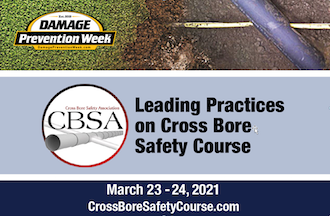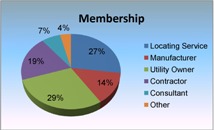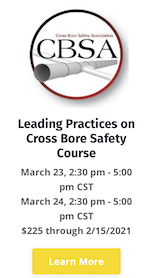
- Home
- History
- News
-
Leading
Practices
-
Legacy Cross
Bores
-
New
Construction
-
System
Integrity
-
Risk Evaluation
-
Drain
Cleaner Safety
-
Videos/Websites
-
Photos-Cross Bores+
-
State
Locating Requirements
-
Papers
and Presentations
-
Tools and Technology
-
Information
Sources
-
Join Now -
Membership
-
Contact
Us
-
Events
-
Directors
-
Search
The Cross Bore Safety Association is a community of industry
professional that have joined together to address all aspects of utility cross
bores for protection against loss of life, injury and property damage.
Leading Practices for Cross Bore Risk Reduction, 88 pages

Course Instructors:
Mr. Mark Bruce,
President, Cross Bore Safety Association
Mr. Mike Kemper, Executive
Vice President, Mears Group
Dr. Samuel Ariaratnam,
Professor, School of Sustainable Engineering and the Built Environment,
Arizona State University - Schools of Engineering
Synopsis:
The Leading Practices for Cross Bore Risk Reduction was finalized in 2019
with includes recommendations from representatives of utility owners,
pipeline installers, inspection service providers, regulators and
manufacturers. A strong focus is offered on cross bores of sewers and gas
distribution and with recommendations useful for all types of utilities. The
target stakeholder includes project managers for utilities, installers and
inspection providers with recommendations for improvement of regulatory rate
support, revision of regulatory safety regulations and Call Before You Dig
legislation. The goal of the document is to achieve faster and more
efficient risk reduction from existing cross bores and minimize the creation
of new cross bores using leading practices. Municipal ordinance revision
recommendations and sewer system operators can contribute to the effort with
resulting improvement for the public and cooperation recommendations which
can lower sewer operation costs due to required inspections of their sewer
systems. Risk modeling, QAQC and the use of GIS data structures are included
throughout the recommendations. In short the document includes details for
operations as well as improvements across all stakeholders, flow charts,
examples of project documentation and descriptive graphics. References
included are extensive and offer a path for further expanding the user’s
knowledge base of cross bores risk reduction.
-----------------------------------------------------------------------------------------
Mission Statement of CBSA
 "The purpose of the Cross Bore Safety Association is to bring persons and organizations together to create comprehensive high quality standards, guidelines, best practices, means and methods, courses, training, instructional materials and other related resources for the education and training of owners, ins
"The purpose of the Cross Bore Safety Association is to bring persons and organizations together to create comprehensive high quality standards, guidelines, best practices, means and methods, courses, training, instructional materials and other related resources for the education and training of owners, ins tallers, regulators, users, inspectors, maintainers and others who can benefit from such so as to minimize the risk for injury, loss of life and property damage from utility cross bores in an effective and efficient manner.”
tallers, regulators, users, inspectors, maintainers and others who can benefit from such so as to minimize the risk for injury, loss of life and property damage from utility cross bores in an effective and efficient manner.”
- Develop "Leading" Practices Guidance Documents
- Utility owner regulatory locating requirements
- New construction procedures
- Legacy verification procedures
- New technology peer review
- Out reach to affected service industries
- Municipal guidelines for acceptable installation practices
Focus of Efforts:
- “The association recognizes the impact from all types of utility cross bores. The association concludes that setting priorities and focus for different types of cross bores will best serve our stated mission statement. The association agrees that the initial focus will be to address cross bores where natural gas lines intersect sewer lines.”
- Other types of cross bores can occur between other combinations of utilities. These may be disruptive, costly and have potential for injury. Intersecting buried electric cables can cause death. Intersecting communications cables can interrupt calls for emergency assistance.
Highlighted on This Page:
● Mission
Statement
● Target
Areas of
Interest
●
Initial Focus
●
Definition of a Utility Cross
Bore
●
Articles Bylaws
Definition of a Utility Cross
Bore
Cross bores are defined as an
intersection of an existing underground utility or underground structure by
a second utility resulting in direct contact between the transactions of the
utilities that compromises the integrity of either utility or underground
structure.
![]() CBSA
completed the
Leading Practices
for Cross Bore Risk Reduction, working with key industry
associations, agencies and leaders, in December 2019. The 88 page Leading
Practices, 32 chapters, 23 figures, 33 references and 12 examples.
CBSA
completed the
Leading Practices
for Cross Bore Risk Reduction, working with key industry
associations, agencies and leaders, in December 2019. The 88 page Leading
Practices, 32 chapters, 23 figures, 33 references and 12 examples.
